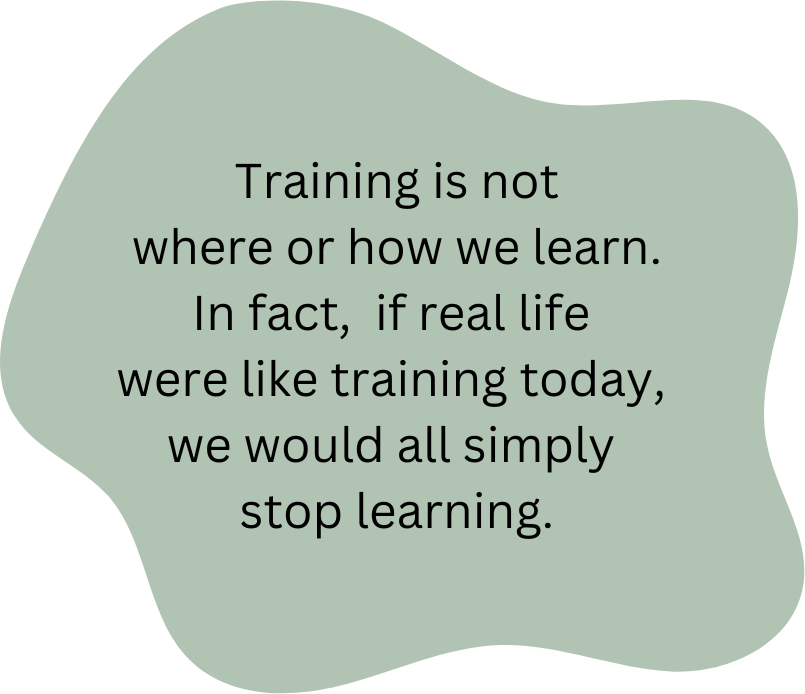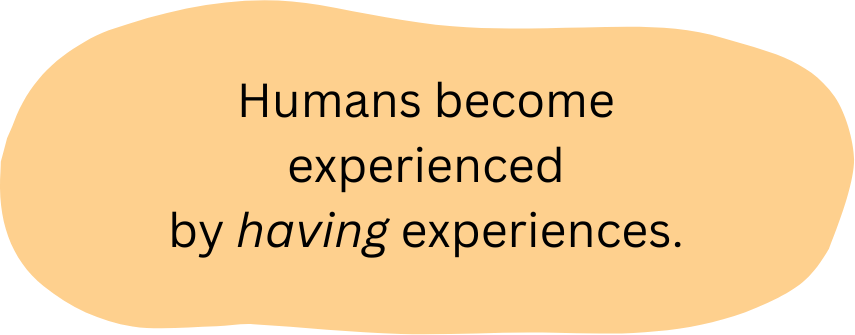You can’t make me (learn like this).
Micah Kessel
on
February 2, 2025

Better training is possible, and that's what this article is about.
“Some of the most valuable life lessons I’ve ever learned came from corporate training.”
Attributed to, well, nobody. .
“Jinkies, that one-off manager feedback session was so helpful that I went through each letter of the feedback framework with my direct reports and our empathy skills and team flow are now amazing!”
Nooope.
“Wow, that (mandatory) empathy exercise / hospital staff leadership training not only improved patient scores but also brought us on a Grey’s Anatomy- feeling, collaborative growth journey. We’re yearning to grow through more empathy skills mandatory training!”
Said no one. Never, ever, ever. Not for core skills or empathy training.
That’s why stock images showing the ‘pitch’ of corporate training look like this: unreal. Whereas the result is an experience drastically different.

Not Exactly a “Warm Bath”
Here is an actual true story, and it will sound familiar:
“I have a friend who works as a flight attendant. Every time they have to do a quarterly digital training, their group chat blows up about what they’re all actually doing: cleaning their rooms, watching Netflix and gossiping about their travel plans.”
The electronic tests at the end of most of these trainings are unfailable, so people do them while actually in the bath and binge-watching Bridgerton reruns. Those people being all of us.
In this post, teetering as always on the shoulders of the brilliant scientists, practitioners, and coaches I’ve worked with over the past two decades, I want to explore one reason why training is this monotonous sea of blah that every organization, healthcare institution, and place of education pays the equivalent of multiple productive employees for, even during downturns – and why it’s something no one is ever excited for, still. I’ve seen organizations give every form of empathy workshop, empathy leadership training, empathy seminar, empathy course, empathy exercise. But teaching with empathy will not train empathy if the teaching part is flawed.
Then, I’m going to tell you about a real-life sea change of learning happening around us, that all of us can partake in – but only if we’re willing to be honest about how warm-blooded adults in the 21st century actually learn.
Let’s rewind for a second: here’s why it is how it is now.
Magic wand wave, poof: You run talent at a hospital. Congrats! It’s going to be a lot of work.
Good news: You’ve got a healthcare or corporate training program in place. It’s a significant line item – both on your budget and on your managers’ calendars. You think your teams enjoy the training well enough, and for a bit, seem to remember and even implement some of what was covered.
How long does that last? A week? A month? Did patient scores improve marginally? Temporarily?

Training is not where or how we learn. In fact, if real life were like training today, we would all simply stop learning.
If you’re an HR/people leader, you get how institutions work, so you’re probably thinking, “of course corporate training, whether broad or training empathy skills for adults, doesn’t feel like a warm bath, author. Yes, hospital training and corporate training is generally check-boxy, short-lived in impact, and not ultimately helpful to accomplish even its own limited set of goals.”
But that’s the problem, isn’t it? We can’t even disassociate training with being an unpalatable waste of time in our imaginations.
But who’s to blame for training being such cardboard?
Not talent development, L&D, chief people officers, chief patient experience officers, chief nursing officers, HR leaders, or DEI leaders.
If we want to point fingers: the original corporate training programs emerged largely out of post-Industrial Revolution management theories that focused on efficiency and compliance, not personal development or engagement.
Pioneers like Frederick Taylor (scientific management) and later, Henry Ford, designed workplace protocols to streamline labor, emphasizing productivity and standardization. Their theories helped companies manage large-scale operations but tended to treat workers as cogs in a machine, leaving little room for personal growth or skill-building.
A Brief History of How Organizational Training Lost Its Humanity

Later, as training expanded in the 1950s and ’60s, programs leaned heavily on military-style, top-down models, which further emphasized obedience over creativity. Early programs were mainly about skill acquisition for specific tasks and compliance, often delivered through lectures or rigid instructional materials.
The result? Training sessions felt impersonal, inflexible, and devoid of real-world applicability, often failing to engage or inspire employees. Much of this style still lingers today, as many companies continue to focus on compliance, uniformity, and scalability at the expense of relevance, empathy, and individual growth. Now, the challenge is modernizing these programs to actually foster skills like empathy, adaptability, and innovation, and we expect L&D, DEI, and chief patient experience officers to change the game, when the players at the table are often just offering the same model-based learning solutions dressed in friendlier clothing.
Do you know who loves acronyms the most? The military. Who loves them the second most? Training programs.
The Lost Opportunity Cost of Training as a Mere Calendar Item
This is why learning and development people are far beyond once burned, twice shy. Year after year the offerings they’re receiving from potential vendors are both stagnant and recycled conceptual promises. But all those concepts don’t even make it into the arena of the interested participant. A manager at a medium-sized company told me that even a mandatory virtual training for their top 100 leaders was attended by 55 of them. A leader at a Top Five tech company told me last week that her expectation on a program for 50,000 employees is max 20%…and that’s considered high. More people come for free food than free “education.” Go figure, but the participants are also not to blame. One talent development leader at a major tech company told me:
“These training companies are very good at creating good experiences that get like 4.9 out of 5 in net promoter scores. That’s what they’re reverse-engineering for. They’re good at people doing a test right after a week and saying, ‘I remember the model, I remember that language, I’m using that word.’ Because they drill the test during the training. But, surprise, surprise: they are mixed at behavior change and I struggle to truly prove durable impact. We’ve tried different things. I’ve paid for ROI assessments. I’ve done ROI assessments. Still it’s really hard – it’s really, really hard – to actually get people to implement things.”
But wasn’t that the whole point ? To actually change the quality of service?
Imagine how any other leader of people would react to this uniquely 21st century bureaucratic waste. In a world in which time and talent are at a premium, you’ve gotten together your most precious resource: your people. You’ve put them through a choreographed training exercise and all they got out of it was some pizza and a box checked on a form.

It’s a uniquely infantilizing experience, whether you’re in healthcare or finance, whether you’re training to provide world-class service or serve in combat.
But that’s what it’s like now. This is just what we do, this is how we treat the capacity, intellect, and finite lifespan of tens of millions of people in the most highly-valued organizations in the world.
Can One-Size-Fits-All Programs Ever Fit Anyone?
It’s because we’re working against human nature.
A new breed of subscription programs offers “multi-skill programs” that you can drop in on like they’re yoga lessons with a random cohort. It’s certainly more stimulating than the animated-video-followed-by-multiple-choice-test straight out of A Clockwork Orange , but they have an inherent challenge too. They’re trying to be both comprehensive and one-size-fits-all, a broad buffet of options for the flexible but uncommitted learner. Everything, everywhere, all during lunch. You get a classic outcome: one-size-fits-all actually fits no one. Instead, people follow their colleagues into the easiest mix of credits or performatively choose what they think their boss wants to see.
So, what works? The answer is simple: what’s always worked.
How Real Learning Happens in Real Life

Think about what actually changed anyone’s behavior in any group you’ve ever been in: –
- One-on-one conversations
- Giving feedback
- Having tough conversations
- Deliberate, realistic, embodied practice
- Lots and lots and lots of reps
People want to learn, but they don’t want to be trained. (It’s OK: they’re not dogs!) People are attracted to gaining new skills and exploring their own capabilities. Humans become experienced by having experiences.
But adult learners face unique challenges as they seek out new experiences. It’s hard to meet new people to practice with as a beginner, and most people don’t choose new experiences as adults anyway, for a fascinating mix of social and cognitive reasons. It’s scary to look foolish at a salsa lesson, or to partner up with someone you don’t know for trivia. Think about how much of our professional socializing is lubricated with alcohol, and even then, how difficult it is to truly connect on important issues when there’s even a hint of a professional context, a context in which the vulnerability of being a beginner is perceived as so costly.
As adult learners, many of us need on-ramps to go through new experiences and try new things.

So how can we install real on-ramps for skill-building for teams at work?
We have to – prepare your shocked gasp here – bring real life experiences into the corporate learning context. Whether we want to improve client outcomes or confront the hard things about soft skills as it applies to inclusion in our workplace, we ought to value experience over training.
Don’t worry: that’s what we do here.

Eight Tenets to Transform Training into Experience-Driven Growth
If we’re going to revolutionize training, it’s going to require a fundamental shift from rote learning and model-based methods to an experience that prioritizes engagement, empathy, adaptability, and relevance to the real life workplace in all its non-one-size-fits-all nuances.
Here are eight tenets that will be, in my opinion, essential to enter the land of real learning:
- Emphasize experiential learning: Hands-on, immersive experiences (like simulations or real-world problem-solving) allow participants to “learn by doing.”
- Personalize the learning experience: Tailoring training to individual needs, roles, and learning styles. If we’re going to be leveraging AI and adaptive learning platforms, this is where a lot of the technical lift will serve clients well. We think that kind of bespoke learning is only possible with high-touch coaches, but there are better, more cost-effective ways than that.
- Incorporate storytelling and emotion: People connect deeply with stories and emotion-driven content. I have witnessed first-hand the positive impact of crafting training around real-life narratives or scenarios. It taps into participants’ empathy and motivates them to retain information. Storytelling also creates memorable anchors, which is critical for sustaining behavior change.
- Focus not on telling people what to think, but getting them to think at all: Most solutions in life are not singular and are highly situational. But situational leadership as a framework is also highly flawed because again, it’s relying on a model. Experiences are what create critical thinking and adaptability, making learners agile and ever evolving to keep up with new demands and prepare leaders and teams to confront an unpredictable future.
- Make training continuous and iterative: Instead of one-off workshops, develop ongoing, evolving training modules. This approach allows employees to integrate learning into their daily routines, adapt in real-time, and revisit material as they progress in their roles. The world of offerings has become “short-burst” and Empathable has as well, but it’s not a solution in and of itself if what happens in that burst isn’t an epiphany.
- Create safe spaces for reflection and dialogue: Through training Big Four consultants, we’ve noticed that they are most successful when they encourage open, non-judgmental discussions that allow participants to process emotions and share experiences. This kind of emotional reflection leads to deeper understanding and connects training content to participants’ daily lives. It’s very hard to do because we’re all so busy, so AI has a chance to optimize that opportunity here as well.
- Measure impact beyond completion rates: Traditional metrics (like attendance or pass rates) don’t tell the whole story. Real impact is measured through behavioral change, team dynamics, and ultimately, the effect on business outcomes. Collect qualitative feedback, track longitudinal data, and assess the practical application of skills over time. We believe your theory of growth for impact and shifting environments towards better skills and culture can be seen through an approach called Two in the Room.
- Interweave inclusion and belonging: Effective training needs to reflect diverse perspectives and be inclusive in both content and delivery. You can experience diverse perspectives without even talking about diversity in the training. Doing so reduces the sense of this being didactic, fosters an exposure to difference that is the key to reducing implicit bias, allows participants to see themselves in the material, and encourages a wider range of ideas and solutions.
Ending the tyranny of training and entering the land of experiences means that learning needs to evolve into an empowering, dynamic process that truly supports both leader and employee growth and equips organizations to navigate the complexities of the modern world. The model-based learning that helped train the military is not going to work in a world where we are looking to not just survive, but live and ideally enjoy that life fully.
- Category: Expert Perspectives
